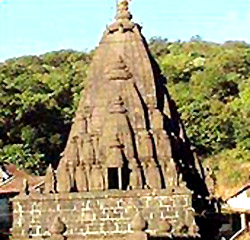 Bhimashankar temple lies on the banks of the river Bhima. Bhimashankar is also the source of the river Bhima, which flows southeast and merges into the Krishna River in Raichur. It may be noted here that according to the Shiv Purana the Bhimashankar Jyotirlinga is situated on the mountain Brahmapur in district Kamrup, Assam.
Bhimashankar temple lies on the banks of the river Bhima. Bhimashankar is also the source of the river Bhima, which flows southeast and merges into the Krishna River in Raichur. It may be noted here that according to the Shiv Purana the Bhimashankar Jyotirlinga is situated on the mountain Brahmapur in district Kamrup, Assam.
Legendary stories surround the Bhimashankar temple. Once a demon Bhima lived with his mother Karkati in the dense forests of Dakini, on the lofty ranges of the Sahyadris. Bhima`s intolerable cruelty was showered upon every human, so that everyone was scared of him. But, what tormented Bhima was the mystery of his own existence. When Bhima urged his mother Karkati to reveal the identity of his father, and why had he abandoned them in the wilderness of the forests, his mother explained that he was the son of Kumbhakarna, the younger brother of the fearful King Ravana, King of Lanka. She also told him that Lord Vishnu in the incarnation of Lord Rama had destroyed Kumbhakarna.
The highly furious Bhima vowed vengeance against Lord Vishnu. Bhima observed severe penance to please Lord Brahma. The compassionate creator was pleased with his perseverance and granted him immense prowess. With so much power in hand, Bhima started wrecking havoc in the three worlds. He defeated King Indra and conquered the heavens. He also defeated a firm believer of Lord Shiva-Kamrupeshwar and stocked him the dungeons.
All his handiwork angered the Gods and they pleaded along with Lord Brahma to Lord Shiva, that He needs to rescue the humankind and the heaven alike. The Lord agreed. Meanwhile, Bhima ordered Kamrupeshwar to worship him instead of Lord Shiva, Kamrupeshwar disagreed, and Bhima infuriated, raised his sword to break the Shiva Linga. But, at that very moment, Lord Shiva appeared himself in his full magnificence, and a terrible war raged. Holy sage Narad requested Shiva to put an end to this war, and then the Lord reduced the demon to ashes, putting an end to the saga of tyranny. All the gods present there urged Lord Shiva to make that place his abode. He then manifested himself in the form of the Bhimashankar Jyotirlinga. It is believed that the sweat, which poured out from Lord Shiva`s body after the battle formed the basis of the Bhimarathi river.
Bhimashankar Temple dates back to the mid 18th century and is an amalgamation of old and new structures built in the Nagara style of architecture. Nana Phadnavis built the shikhara (apex) of the temple. Shivaji, the bounteous Maratha ruler is said to have supervised the carrying out of worship services. As with other temples in this part of the country, the sanctum is at a lower level. Mahashivratri is the best time to visit the temple, as the premises come to life with grand festivities.





















